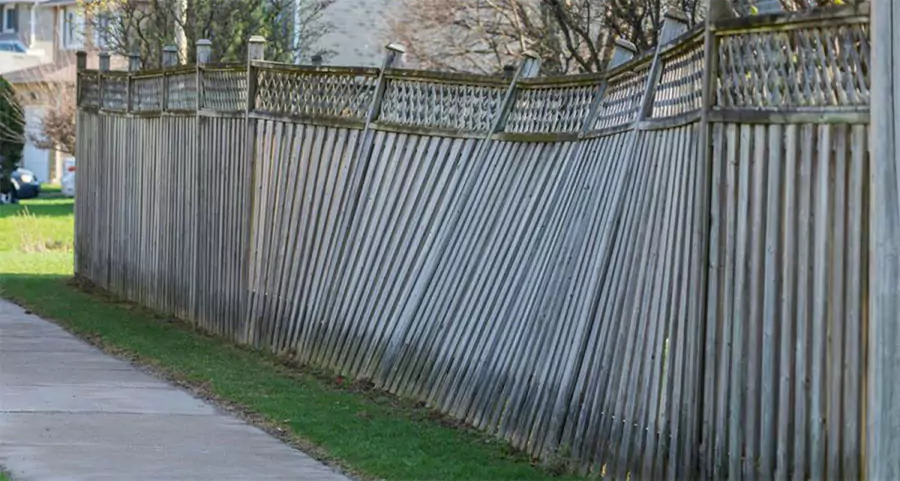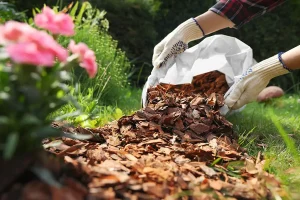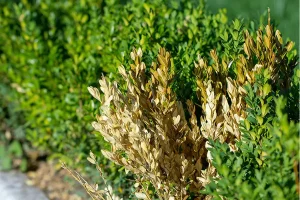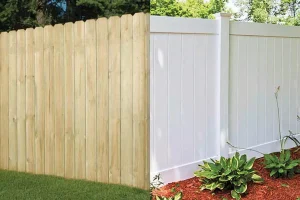A leaning fence can make your yard look messy, block your view, or even fall over. In places like Frisco, Plano, and other parts of TX, this is a pretty common sight, especially with all the weather changes and soil movement. Whether it’s a wood fence, an iron fence, or even a chain link, leaning doesn’t mean it’s the end. It just means something’s going on behind the scenes (or posts!). Fortunately, an affordable fence company in Frisco, TX, can diagnose the issue and restore your fence before it gets worse.
So what’s making your fence tilt like it’s trying to take a nap? And more importantly, how can you fix it without breaking the bank? Let’s look at the most common reasons fences lean—and how a local fence contractor like Stonebridge Lawn and Garden can help straighten things out.
Have you noticed your Frisco fence leaning like it’s about to give up?
Leaning fences are super common in North Texas thanks to shifting soil, wild weather, and rushed installs. From wobbly posts to wind damage, your fence could be failing fast. The good news? A reliable fence service in Frisco knows exactly how to fix it, without making your wallet cry.
Get the best fence look back with help from a local pro who understands what your yard and structure need. Whether it’s replacing warped boards, resetting posts in concrete, or reviving your beautiful arbor, the right contractor can bring your fence back to life—and keep it standing strong for years.
Don’t wait for your leaning fence to become a falling fence. Contact Stonebridge Lawn and Garden today for honest pricing, dependable repairs, and top-notch board-on-board and Frisco fence solutions done right.
What Are the Most Common Reasons for Leaning Fences?
If your fence is leaning, there’s usually a reason behind it—and it’s not just bad luck. Let’s look at some common causes that can make even the best-built fences start to tilt.
-
Clay Soil in Frisco Moves a Lot
Frisco has clay-heavy soil that shrinks in dry weather and swells when it rains. One minute it’s rock hard, and the next it’s soft and soggy. This movement can push or pull fence posts, especially wooden ones, making your fence lean over time.
Shifting soil – The ground underneath moves around when wet or dry, messing up the post’s position.
Poor drainage – If water puddles around the base, it weakens the soil and causes the post to wiggle.
Soil erosion – Wind and rain can slowly take away the dirt that holds your fence steady.
-
Skipping Concrete Weakens the Base
Every strong fence needs a solid base, and that usually means setting the posts in concrete. But sometimes, builders rush or try to cut costs and skip this step. Or maybe they used too little concrete or mixed it wrong.
No concrete footing – Posts set in dirt instead of concrete are easier to push over.
Shallow holes – Fence posts need to be buried deep to stay strong, at least one-third of the post length.
Loose concrete – If it cracks or shifts, it won’t support the post anymore.
-
Old Fences Break Down Over Time
Wood and iron fences can only hold up so long before they start to wear out. Wood rots, rust eats away at the metal, and even cedar fences eventually weaken if they’re not cared for properly. Once the materials get soft or loose, the fence starts to lean.
Rotting wood – Moisture, insects, or no stain protection can wear it down.
Rusty iron – Wrought iron fences look fancy, but rust can make them flimsy.
Loose nails or screws – Parts come apart, and the fence loses its shape.
-
Texas Weather Can Knock a Fence Out of Line
North Texas weather isn’t always gentle. Strong winds, heavy storms, or even hail can loosen posts or knock fence panels out of place.
Wind damage – Tall fences or ones without good support act like sails.
Storm impact – Falling branches or flying trash can hit and tilt the structure.
Weak joints – If the fence isn’t built with strong braces, it won’t handle the pressure.
-
Poor Craftsmanship Leads to Leaning Fences
When a fence is installed too fast or without care, trouble usually follows. Crooked posts, bad spacing, and missing support pieces can all cause leaning sooner than expected. A rushed job may save money at first, but it often leads to bigger repair bills later.
Bad craftsmanship – Crooked posts, uneven panels, or no support beams = leaning trouble.
Wrong materials – Using soft wood instead of cedar or skipping stain can make fences fall apart faster.
No warranty – If there’s no backup from the company, repairs are on you.
I started noticing that my fence was leaning a bit in my backyard on Whispering Pines Drive in Frisco. At first, I didn’t think much of it, but as time went on, it became more noticeable, and I realized I had a real problem on my hands.
I reached out for help, and it turned out that the clay-heavy soil in Frisco was to blame. The soil would shrink and swell with the weather, and that movement had pushed my wooden fence posts out of place, causing them to lean.
The team that came out explained how the shifting soil was causing the fence posts to shift and weaken, and they also pointed out that there was no concrete footing for some of the posts. They explained that the posts needed a solid base to stay strong and that some of the posts were just set in dirt.
After inspecting everything, they recommended reinforcing the posts with concrete and repositioning the leaning ones to make sure they wouldn’t move again. They also noticed some of the wooden panels had begun to rot due to moisture, so they replaced the damaged wood and added extra support to the structure.
They worked quickly to fix the leaning sections and used stronger materials to reinforce the fence, ensuring it would last longer in Frisco’s tough weather. Now, my fence is standing strong again, and I no longer have to worry about it tipping over every time a storm rolls through.
– Jack, Whispering Pines Drive, Frisco, TX
How Can a Fence Contractor Fix a Leaning Fence?
That depends! Sometimes, a repair is all you need. Other times, the whole fence might need replacing, especially if it’s really old or badly damaged. They can do the following:
Post replacement – If one or two posts are weak, they can be dug out and replaced with new ones (with concrete this time).
Re-align panels – Boards and panels can be taken off, straightened, and put back correctly.
Add support – Braces or cross beams can keep things sturdy without needing to rebuild the whole fence.
Should You Stain or Treat Your Wood Fence?
Yes—staining or sealing your wood fence is a smart move, especially for cedar. Stain helps block out moisture, sun, and bugs, preventing cracks and rot. A sealant adds extra protection and makes the fence easier to clean, keeping it strong and good-looking for years.
What If You Have a Wrought Iron Fence?
Wrought iron fences are strong and stylish, but they still need care. Over time, rust can build up, and sections might bend or break. A skilled fence contractor can remove rust by scraping and sanding it off, then repaint the fence with a weather-resistant coating to help protect it. If any parts are damaged, they can often be fixed with welding.
In cases where sections are too bent or broken, the contractor can simply replace the damaged panels instead of the whole fence. If the iron fence is beyond repair, it might be time to install a new one with updated features for strength and style.
How Can an Affordable Fence Company in Frisco, TX, Like Stonebridge Lawn and Garden Help?
Stonebridge Lawn and Garden is your go-to crew for fence repair and fence installation. If you need a new cedar fence, help fixing a board-on-board design, or want to upgrade to a chain link or wrought iron fence, they’ve got the skills, tools, and friendly crew to do it right.
They focus on strong craftsmanship, good communication, and fair pricing. Their fences are made to last, and they offer a warranty so you can relax.
Need a fresh start? Stonebridge can also tear down your old, leaning fence and install a new one that fits your style—wood, iron, or anything in between.
I noticed my fence on Oak Ridge Drive in Frisco was starting to lean. It wasn’t just a small issue – it had become a real eyesore and I was worried about it getting worse with every storm. I called Stonebridge Lawn & Garden after hearing good things from a neighbor. They came out to assess the situation and quickly figured out what was going on.
The posts were loose due to shifting soil, and some of the boards were warped from exposure to the elements. The team explained they could either repair the fence or replace it entirely, depending on my preference.
I decided to go for a fresh start since the fence was already in bad shape. They removed the old, leaning fence and installed a new cedar fence that perfectly matched the style I wanted for my yard.
The process was straightforward – they tore down the old fence, set strong, secure posts in concrete, and installed the new boards with attention to detail. The crew was friendly and professional, keeping me updated throughout the entire project.
The best part was that they offered a warranty, which gave me peace of mind knowing that my new fence would last. Now, my backyard looks great, and I don’t have to worry about the fence tipping over anymore.
– Emily, Oak Ridge Drive, Frisco, TX
Conclusion
If your fence is starting to look like the Leaning Tower of Texas, it’s time to call in the pros. Don’t let wind, weather, or wobbly wood ruin your view. A leaning fence isn’t just annoying—it can also be a safety problem.
Stonebridge Lawn and Garden makes fence repair simple, and they also offer brand-new installations when repairs won’t cut it. From cedar to iron to board-on-board fences, they bring strong results, friendly service, and reliable work all over Frisco, Plano, and nearby TX towns.
Contact Stonebridge Lawn and Garden today at (972) 625-0066 to schedule your fence check-up or get a quote on a new fence.
Frequently Asked Questions
1. Why is my new fence leaning already?
It might be a poor installation. If the posts aren’t set deep enough or without concrete, they can start to lean, even if the fence is new.
2. Can heavy rain cause a wood fence to lean?
Yes! Water can soak the soil and loosen the base, especially if there’s no good drainage. Wet soil = wobbly fence posts.
3. What kind of fence lasts the longest in TX?
Cedar fences are great for Frisco’s weather, especially when stained and sealed. Wrought iron fences also last long, but need rust control.




